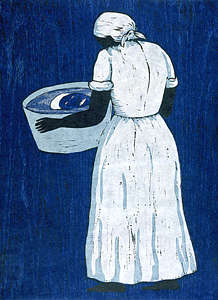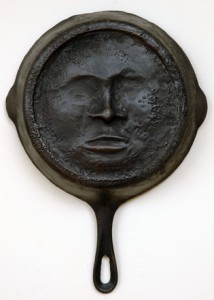In Washtub Blues (2000)and Mirror, Mirror (2006), both images of reflection, Scripps alumna Alison Saar ’78 continues her career-long exploration of Black female identity. Washtub Blues is a woodcut print that Saar created on commission for the Women of the West Museum and the Boulder Museum of Contemporary Art in Boulder, Colorado for Expanded Visions: Women Artists Print the American West. As a participant in the project, Saar was one of four women artists who worked with printmaker Bud Shark to generate works that drew on their respective, culturally disparate personal experiences. This print shows the back of a barefooted, head-covered black woman holding a washtub. The water in the tub reflects her face, which is not visible otherwise. Almost two-dimensional, the work is a departure from the artist’s trademark sculptural forms. However, the African American female subject and the Black folk aesthetic make the piece distinctly Saar’s.
Mirror, Mirror, too, shows a reflected Black female face. Instead of reflected in water, though, facial features morph out of a skillet. The skillet is a common form in Saar’s work of the last decade. Like the washtub, the skillet references African American history: cooking with a cast iron skillet and washing clothing in a wooden washtub are parts of a Black (female) cultural tradition. With these images Saar suggests that Black women might look to symbolic forms that refer to almost ritual behaviors, such as cooking and cleaning, and to their past more generally in their searches for identity. This use of a cultural visual vocabulary and reference to the past are definitive of Black art, a genre within and from which Saar works.
The daughter of sculptor Betye Saar and painter and art conservator Richard Saar, Alison Saar began exploring this aesthetic under Dr. Samella Lewis while earning an undergraduate degree in art history at Scripps. There, Saar studied Caribbean and Black folk art. She wrote her senior thesis on self-taught Black artists.
After graduating, Saar switched her focus from the history to the making of art: she remained in her native Los Angeles to pursue an MFA at the Otis Art Institute of the Parsons School of Design. Soon after receiving her degree, she moved to New York, where she had her first solo exhibition (Monique Knowlton Gallery, 1984). In 1985, she left the city for an artist residency at Roswell, New Mexico, where she augmented her urban style with Southwest Native American and Mexican elements. It was at Roswell that she created her first life-sized female sculpture.

Alison Saar: “Washtub Blues”, 2000. Woodcut. Gift of Alison Saar.
Since her short stint in New Mexico, the full-sized female figure has become a kind of trademark form in the artist’s oeuvre. Saar is best known for her sculpture, and with it she has made a name for herself as a Black artist who addresses race and, more particularly, womanhood in her work. Her self-proclaimed focus is the Black female.
In 2000, Saar’s work was shown alongside that of her sister, Lezley, at the Williamson Gallery. Her work continues to be exhibited at institutions across the county: she is represented by the Phyllis Kind Gallery in New York and Jan Baum Gallery in Los Angeles, and her work is included in the permanent collections at the Metropolitan Museum of Art, the Museum of Modern Art, the Studio Museum in Harlem, and the Whitney Museum of American Art, among many others. Her monumental memorial sculpture of Harriet Tubman stands in Harriet Tubman Plaza at 125th Street in Harlem.
She was recognized for her artistic and social accomplishments with the Scripps College Distinguished Alumna Award in 2003.
Reference
- Mary Davis MacNaughton. Alison and Lezley Saar. Los Angeles: Perpetua Press. 2000
Written by Zoe Larkins (SC ’09), Summer 2008 Wilson Intern.


